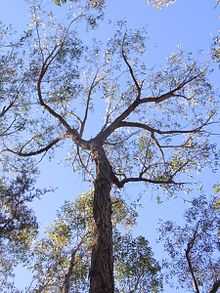Eucalyptus eugenioides
| Thin-leaved stringybark | |
|---|---|
 | |
| Blue Mountains National Park, Australia | |
| Scientific classification | |
| Kingdom: | Plantae |
| (unranked): | Angiosperms |
| (unranked): | Eudicots |
| (unranked): | Rosids |
| Order: | Myrtales |
| Family: | Myrtaceae |
| Genus: | Eucalyptus |
| Species: | E. eugenioides |
| Binomial name | |
| Eucalyptus eugenioides Sieber ex Spreng. | |
| Synonyms | |
|
Eucalyptus nigra R.T.Baker | |
Eucalyptus eugenioides, known as the thin-leaved stringybark, is a common eucalyptus tree in eastern Australia. It grows up to 30 metres (100 ft) tall in grassy forest or dry eucalyptus woodland on deep heavy soils of moderate fertility.[1]
Taxonomy
The thin-leaved stringybark was described by Kurt Polycarp Joachim Sprengel in 1827,[2] although George Bentham in his Flora Australiensis regarded it as a subspecies of E. piperita.[3] The species name relates to its similarity to trees of the genus Eugenia.[4] Common names include pink blackbutt, small-leaved stringybark, Wilkinson's stringybark, white stringybark, as well as thin-leaved stringybark.[2] The term "stringybark" refers to the long, thin bark fibres that can be pulled off the tree trunk in strings.[5]
Description
The thin-leaved stringybark is a straight-trunked tall tree that reaches 30 m (100 ft) high with a trunk that can be 70 cm (28 in) wide at chest height.[4] Stringy in nature, the bark is grey to red-brown and remains on the tree. The matte green adult leaves are lanceolate (spear-shaped), and measure 10–14 cm (4–5.5 in) long, 2–3.3 cm (0.8–1.3 in) wide. The white flowerheads are arranged in groups of eleven and appear erratically anywhere from March to September.[6]
Distribution and habitat
The thin-leaved stringybark is found across eastern New South Wales from Wyndham north to the Queensland border,[6] and then continues to the vicinity of Warwick in southeastern Queensland, with scattered populations further north as far as Gladstone.[4] It is a common tree of shale- and slate-derived moderately fertile soils in lowlands and low hills. It grows in open forest with other trees such as grey box (E. moluccana), forest red gum (E. tereticornis), cabbage gum (E. amplifolia), manna gum (E. viminalis), woollybutt (E. longifolia), narrow-leaved ironbark (E. crebra), and argyle apple (E. cinerea), spotted gum (Corymbia maculata), and paperbark species such as prickly paperbark (M. styphelioides) and white feather honeymyrtle (M. decora).[4][7] The thin-leaved stringybark is one of the key canopy species of the threatened Cumberland Plain Woodlands.[8]
Ecology
The thin-leaved stringybark regenerates by regrowing from epicormic buds after bushfire and can live for more than a hundred years.[7] The longhorn beetle species Adrium artifex has been recorded from the thin-leaved stringybark.[9]
Cultivation
Eucalyptus eugenioides has been grown in California, where it grows best in coastal areas.[10] In New South Wales, it is also known as "good kind stringybark" by beekeepers as the bees feeding on it are healthy and produce honey with a well-balanced amino-acid profile. It also provides the last crop of pollen before winter.[11]
References
- ↑ Les Robinson - Field Guide to the Native Plants of Sydney, ISBN 978-0-7318-1211-0 page 45
- ↑ 2.0 2.1 "Eucalyptus eugenioides Sieber ex Spreng.". Australian Plant Name Index (APNI), IBIS database. Centre for Plant Biodiversity Research, Australian Government.
- ↑ "Eucalyptus piperita var. eugenioides Benth.". Australian Plant Name Index (APNI), IBIS database. Centre for Plant Biodiversity Research, Australian Government.
- ↑ 4.0 4.1 4.2 4.3 Boland, Douglas J.; Brooker, M. I. H.; Chippendale, G. M.; McDonald, Maurice William (2006). Forest trees of Australia. Collingwood, Victoria: CSIRO Publishing. p. 304. ISBN 0-643-06969-0.
- ↑ Walters, Brian (November 2009). "ANPSA Plant Guide: Eucalyptus, Corymbia and Angophora - Background". Australian Native Plants Society (Australia). Retrieved 7 September 2011.
- ↑ 6.0 6.1 New South Wales Flora Online: Eucalyptus eugenioides by Hill, Ken, Royal Botanic Gardens & Domain Trust, Sydney, Australia.
- ↑ 7.0 7.1 Benson, Doug; McDougall, Lyn (1998). "Ecology of Sydney plant species:Part 6 Dicotyledon family Myrtaceae". Cunninghamia 5 (4): 809–987.
- ↑ Department of Sustainability, Environment, Water, Population and Communities (20 June 2011). "Cumberland Plain Woodlands". Australian Government. Retrieved 7 September 2011.
- ↑ Hawkeswood, Trevor J. (1993). "Review of the biology, host plants and immature stages of the Australian Cerambycidae (Coleoptera). Part 2, Cerambycinae (Tribes Oemini, Cerambycini, Hesperophanini, Callidiopini, Neostenini, Aphanasiini, Phlyctaenodini, Tessarommatini and Piesarthrini". Giornale Italiano Di Entomologia 6: 313–55.
- ↑ McMinn, H.E.; Mamo (1969) [1937]. Pacific Coast Trees. Berkeley, California: University of California Press. p. 313.
- ↑ Honeybee Australis (2010). "Thin-leaf stringybark". Beekeeping in Australia. Retrieved 7 September 2011.